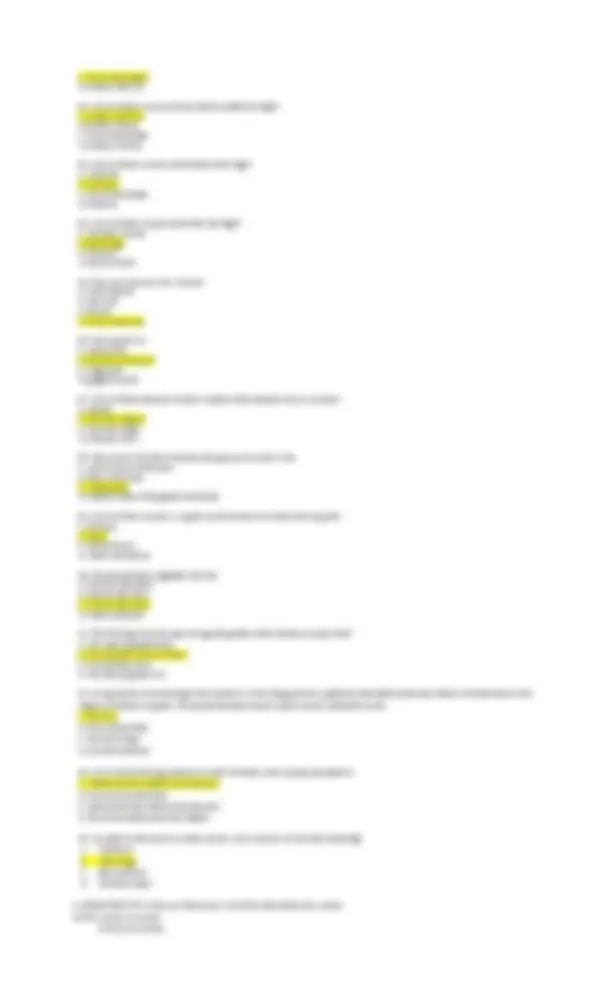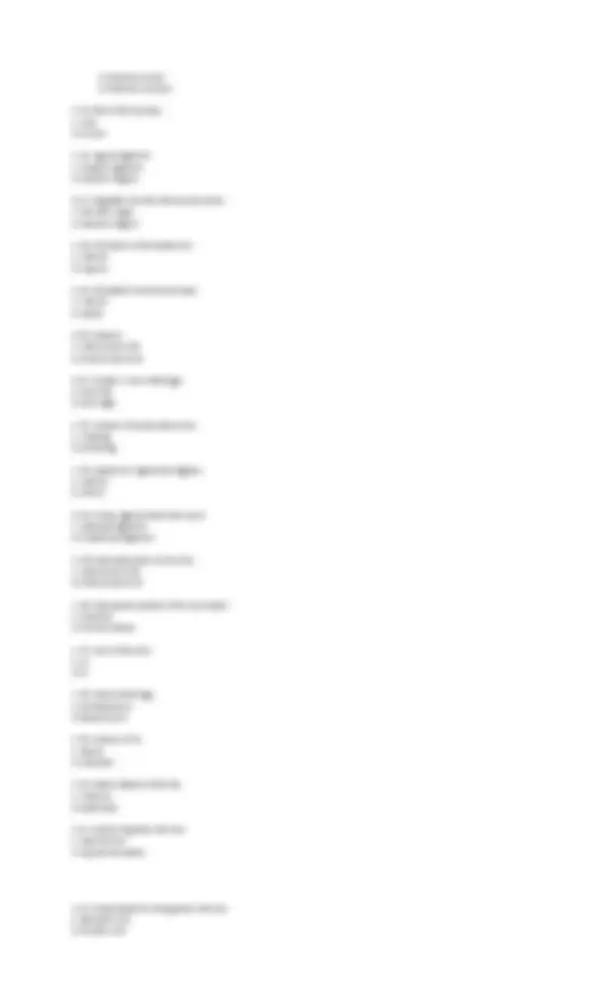





Study with the several resources on Docsity

Earn points by helping other students or get them with a premium plan


Prepare for your exams
Study with the several resources on Docsity

Earn points to download
Earn points by helping other students or get them with a premium plan
Community
Ask the community for help and clear up your study doubts
Discover the best universities in your country according to Docsity users
Free resources
Download our free guides on studying techniques, anxiety management strategies, and thesis advice from Docsity tutors
A school-based review examination that consists of the anatomy of the hips and pelvis. It is a multiple-choice set of questions with highlighted answers 1-44 items
Typology: Quizzes
1 / 5

This page cannot be seen from the preview
Don't miss anything!




General Instruction. Encircle the LETTER that BEST correspond your answer.
B. Anterior superior iliac spine D. Posterior superior iliac spine
Which of the following nerves innervates at least one muscle that acts on both the hip and knee joints? A. Saphenous nerve B. Ilioinguinal nerve C. Femoral nerve D. Common peroneal nerve
A femoral hernia descends through the femoral canal, and the neck of the sac lies- A. lateral to the iliacus muscle. B. at the saphenous opening. C. below and lateral to the pubic tubercle. D. in the obturator canal.
In walking, the hip bone of the suspended leg is raised by which of the following muscles acting on the supported side of the body? A. Gluteus maximus B. Gluteus medius C. Obturator internus D. Obturator externus
In the adult, the chief arterial supply to the head of the femur is from the- A. obturator artery. B. branches from the medial and lateral circumflex femoral arteries. C. deep external pudendal artery. D. inferior gluteal artery.
Which of the following muscles is a flexor of the thigh? A. Adductor longus B. Gracilis C. Psoas D. Obturator internus
The floor of the femoral triangle is formed by the following muscles except which? A. The pectineus B. The adductor longus C. The iliacus D. The adductor brevis
The following structures pass through the subsartorial canal except which? A. The nerve to vastus lateralis B. The femoral artery C. The saphenous nerve D. The femoral vein
The femoral ring is bounded by the following structures except which? A. The femoral vein B. The lacunar ligament C. The femoral artery D. The inguinal ligament
When performing injection to the buttocks area, which of these is the safest area to inject the syringe? A. Upper inner quadrant B. Upper outer quadrant C. Lower inner quadrant D. Lower outer quadrant
The base of the femoral triangle is formed by the- A. adductor longus muscle. B. inguinal ligament C. sartorius D. femoral artery
The lateral border of the femoral triangle is formed by the- A. adductor longus muscle. B. inguinal ligament C. sartorius D. femoral artery
Which of these is the medial attachment of the inguinal ligament? A. Symphysis pubis B. Anterior superior iliac spine C. Pubic tubercle D. Pubic crest
Which of these muscles when paralyzed will manifests a positive Trendelenburg sign? A. Gluteus maximus and Hamstrings B. Gluteus medius and minimus C. Adductor longus and magnus D. Quadriceps femoris
Which of these muscles cannot laterally rotate the thigh? A. Gemellus superior B. Obturator internus
C if both are correct D if both are incorrect C. 45. Parts of the hip bone: A. Ilium B. Ischium A. 46. Inguinal ligament: A. Poupart’s ligament B. Adductor magnus B. 47. Originates from the inferior pubic ramus: A. Adductor longus B. Adductor magnus A. 48. Orientation of the acetabulum: A. Anterior B. Superior C. 49. Orientation of the femoral head: A. Anterior B. Medial B. 50. Nutation: A. Anterior pelvic tilt B. Posterior pelvic tilt B. 51. Increase in neck-shaft angle: A. Coxa vara B. Coxa valga A. 52. Increase in femoral anteversion: A. In-toeing B. Out-toeing A. 53. Location of Y-ligament of Bigelow: A. Anterior B. Inferior D. 54. Primary ligament that limits hip IR: A. Iliofemoral ligament B. Pubofemoral ligament A. 55. Weak abdominals will result to: A. Anterior pelvic tilt B. Posterior pelvic tilt A. 56. Close-packed position of the hip include/s: A. Extension B. External rotation A. 57. Level of iliac crest: A. L B. S A. 58. Medial hamstrings: A. Semitendinosus B. Biceps femoris C. 59. Action/s of TFL: A. Flexion B. Abduction A. 60. Lateral rotator/s of the hip: A. Piriformis B. Quadriceps C. 61. Action/s of gluteus maximus: A. Hip extension B. Hip external rotator A. 62. Compensation for weak gluteus maximus: A. Backward lurch B. Forward lurch
C. 63. Inserted to the ITB: A. Gluteus maximus B. TFL A. 64. Inserted to the greater trochanter: A. Gluteus medius B. Gluteus maximus